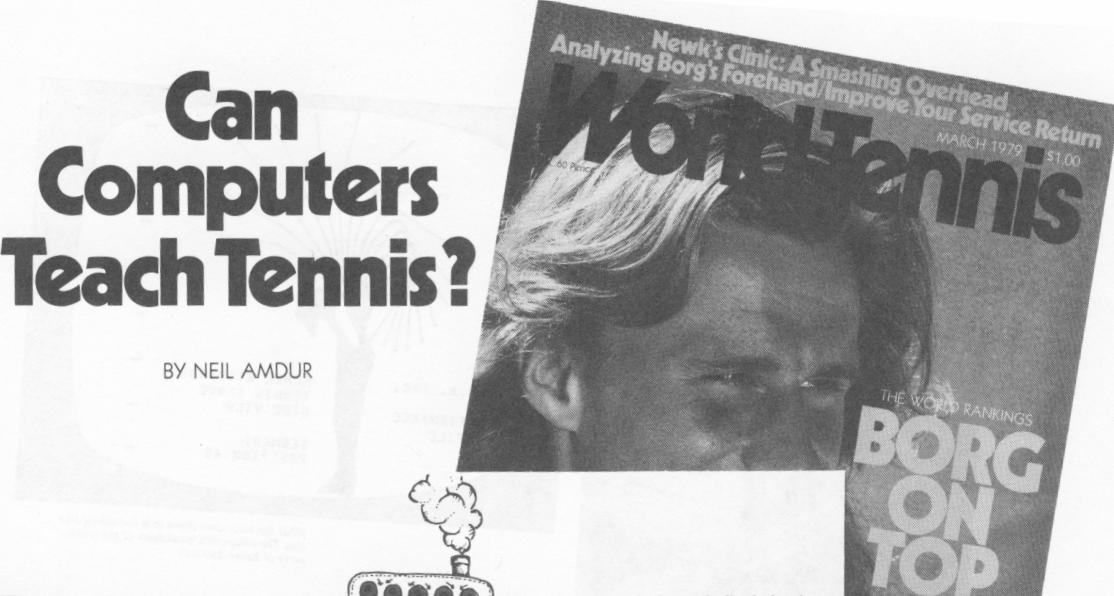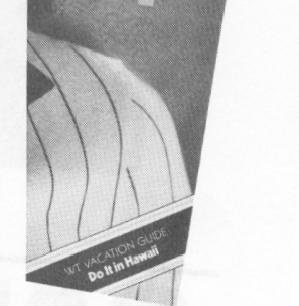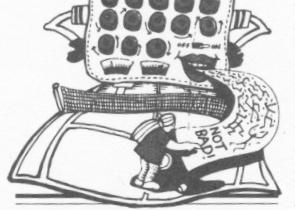| Index | Next |
![]()
DENNIS VAN DER MEER was
skeptical. He had heard all the talk about computers in sports, but didn't feel they could tell him anything he did not already know about teaching tennis. And yet, in the subterranean reaches of his mind, Van der Meer wondered whether the computer could pick up something that the human eye might miss. Had he spent 20 years teaching in vain?
To resolve this doubt, Van der Meer phoned Gideon Ariel, the guru of biomechanical analysis whose computerized studies have been used to determine the efficiency of everything from exercise machines to shock-absorbing material.
Ariel, an ex-Israeli Olympic discus man and shotputter, had dabbled in tennis science as early as 1971, completing studies on tennis balls and rackets for Spalding, constructing his prototype of the perfect racket and filming the serves of Chris Evert, Ilie Nastase, and Vijay Amritraj for Vic Braden, another leading teaching pro.
Ariel was not a tennis nut or tennis player. But he was curious about some of Van der Meer's questions: Could teaching techniques, for example, carry over on the serve for the slow or beginning player to the advanced player? What really happened on the topspin forehand? Could computers assist in the teaching process?
The experiment started at one of the clinics in Van der Meer's Tennis University at Sweet Briar College. Using high-speed cinematography, Ariel filmed the serve using beginners and Van der Meer. The results convinced Van der Meer that computers may be the next major breakthrough in teaching.
"When I saw the value of computer
The pro of the future
may be depending on
an assistant with a heart
of transistors and a
high-speed camera for
an eye.
teaching," said Van der Meer, "I wanted every tennis pro to have the opportunity. No longer will lessons be subjective. No student will be handed a lot of BS. The student will know exactly what he's getting, and the value of the pro will go up enormously."
Ariel was able to draw several important conclusions from his study. They included the fact that a carryover mechanism does exist from the slow to the fast serve and that sequential teaching of the serve is beneficial to skill acquisition.
Van der Meer says that the difference between the average hacker and the touring pro is that the pro has found successful sources and customized these sources to fit individual needs. "Our problems as teachers," he adds. "is what is sound and what is customized. That is where computer analysis can add something."
Many teaching pros now use videotape machines to assist in clinics. The machines provide instant playback for
the pros and instant feedback for the students. According to Ariel, however, the machines cannot deal with velocity, forces, angle and changes of gravity, perhaps the most important elements in shaping good shotmaking.
On the serve, for example, hitting the ball with your back leg off the ground creates a loss of energy, according to Ariel. "You think you're serving faster by jumping, but you're not," said Van der Meer.
Jumping may seem to work for someone like 5'6" Harold Solomon, who is often seen leaving his feet on the serve. But the actual impact, according to Ariel, takes place before his back leg is off the ground.
A similar illusion exists with Ilie Nastase's serve, which Ariel filmed while Nastase played World Team Tennis. "I can look at Nastase and say it seems to me his body is ahead of his front foot," Ariel relates. "Actually, he is five centimeters behind."
Ariel believes the camera does not lie, particularly when you are shooting at 200 to 300 frames per second. When he says that Chris Evert could increase the speed of her serve 20 miles per hour by stabilizing her wrist, he says he has the numbers to confirm this thesis.
Ariel also now believes that players are spinning yarns when they talk about all the racket manipulation attached to topspin shots. "Its a false feel," says Ariel. What really happens, he says, is that the tangential angle is 90 degrees to the radius of the ball. The ball comes, hits the racket and leaves with the racket still head on, Ariel adds. It is the low to high movement of the racket, the strings perpendicular to the radius of the ball, not the arm action, or magical powers of a Bjorn Borg or t'.uolino, Stoll, that create the looping
March 1979 World Tennis 35
WnP/ n 7- u- "-



![]()
| Index | Next |